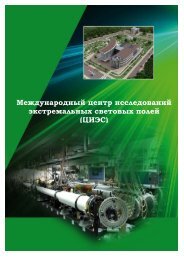Exawatt Center for Extreme Light Studies (XCELS)
Exawatt Center for Extreme Light Studies (XCELS)
Exawatt Center for Extreme Light Studies (XCELS)
Create successful ePaper yourself
Turn your PDF publications into a flip-book with our unique Google optimized e-Paper software.
5<br />
The resulting radiation at the output of the laser complex will have the following<br />
parameters: power 200 PW, pulse duration 25 fs, wavelength 910 nm, divergence not<br />
more than 3 diffraction limits.<br />
Along with the subexawatt laser <strong>XCELS</strong> will house a 100 MeV linear accelerator of<br />
electrons and unique laboratories <strong>for</strong> experiments on the physics of strong fields, highenergy<br />
physics, laboratory astrophysics and cosmology, nuclear optics, neutron physics,<br />
laboratories <strong>for</strong> studying the properties of vacuum, attosecond and zeptosecond physics,<br />
and fundamental metrology. <strong>XCELS</strong> will also comprise a powerful center <strong>for</strong> data<br />
processing and computer modeling of the interactions of extreme light fields.<br />
<strong>XCELS</strong> will be a unique research center of international level both in terms of the<br />
radiation source parameters and the planned research program. The period of superiority<br />
over the existing facilities and the ones constructed outside Russia intended <strong>for</strong> studies of<br />
extreme light fields will begin with the launch of the first laser prototype with the power<br />
level of 10 PW (2014) and will continue with the rise in the laser complex power (2018).<br />
The future superiority will be ensured by creation of a source of electromagnetic radiation<br />
with peak power exceeding 1 <strong>Exawatt</strong> on the basis of the interaction of multipetawatt laser<br />
pulses with plasma in the ultrarelativistic regime (2020). The superiority of the collective<br />
program of experimental studies will be maintained from the beginning of the first<br />
experiments on the two-channel prototype (2015) and far-reaching.<br />
Fig. 1.2. Prospective view of <strong>XCELS</strong>



